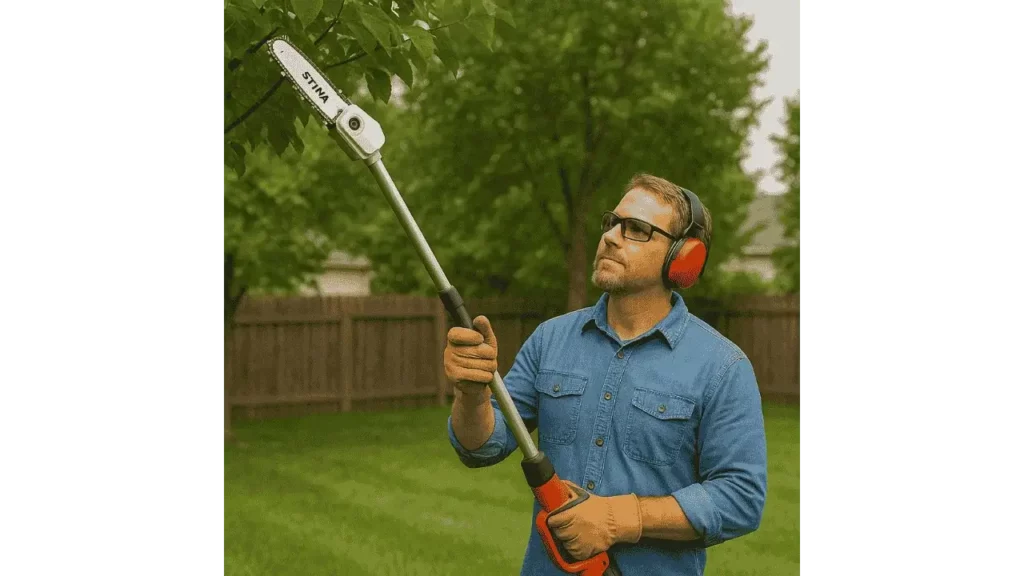Pole saws might not get much attention until you actually need one. I remember the first time I used one after wrestling with a ladder and a handsaw to trim a stubborn branch; it felt like I had discovered a cheat code. These tools aren’t quite chainsaws, and they’re nothing like hedge trimmers, but they fill a critical gap. If you’ve got tall trees, awkward branches, or dense shrubbery, a pole saw makes pruning safer and much easier. It removes the need to balance on a ladder with a blade in hand and instead lets you cut with precision from the ground.

What Makes a Pole Saw Useful?
Elevated Reach Without a Ladder
One of the biggest advantages of a pole saw is its ability to reach high branches while keeping your feet planted firmly on the ground. Whether gas-powered, electric, or battery-operated, pole saws typically extend anywhere from 8 to 15 feet.
“Using a pole saw greatly reduces the need for ladders, which are one of the leading causes of home gardening accidents,” notes Brian Mendez, a certified arborist based in Colorado. This reach translates into not only efficiency but also peace of mind.
Ideal for Pruning and Light Trimming
Pole saws are designed for specific tasks, primarily pruning branches up to 8 inches in diameter. While they won’t replace a full-sized chainsaw for heavy-duty work, they excel at managing overgrowth in trees, clearing storm-damaged limbs, or shaping tall hedges. Their lighter weight and narrow blade profile make precision cuts possible, even from a distance.
Pros That Make Pole Saws a Smart Investment
Improved Safety and Ergonomics
Cutting overhead is inherently risky. A pole saw minimizes the risk by eliminating the need to climb. Many models now come with cushioned handles, anti-vibration technology, and well-balanced designs that reduce fatigue even during extended use. For those with moderate upper body strength, battery-powered models in particular strike a good balance between power and manageability.
Versatility for Yard Maintenance
Pole saws aren’t just for tree pruning. Some models come with interchangeable heads or attachments, allowing for hedge trimming or even pole-mounted chainsaws. Their adaptability across seasons; spring pruning, summer shaping, and fall cleanup makes them a multi-season solution.
Quick Start and Minimal Setup
Compared to gas chainsaws, electric and battery-powered pole saws require less maintenance and are quicker to start. Plug them in or attach a charged battery, and you’re ready to go. This simplicity encourages more frequent use and makes small tasks feel less like a chore.
“Homeowners often underestimate how much easier pruning becomes with a pole saw. It’s one of those tools that pays for itself the first time you avoid hiring a tree service,” adds Tina Caldwell, a landscape equipment technician with over two decades of field experience.
Where Pole Saws Might Fall Short?
Limited Cutting Power
While pole saws handle small to medium branches with ease, they aren’t meant for cutting down trees or slicing through thick logs. Attempting to use one beyond its intended purpose can not only damage the tool but also compromise your safety. For branches over 8 inches in diameter, a chainsaw remains the better choice.
Can Be Awkward to Maneuver
Even with ergonomic designs, a fully extended pole saw can become tiring to use, especially for overhead cuts. Balancing and guiding the blade at such a distance takes some getting used to. Users often report that the longer the pole, the less control they have, particularly when dealing with tough angles or dense canopies.
Battery Life and Cord Length Limitations
Corded electric models are limited by the length of your extension cord, while battery-operated ones depend on run time, usually averaging 30 to 60 minutes per charge. For larger yards or extended use, this can mean stopping mid-task to recharge or swap batteries, something worth factoring in before purchase.
When Is a Pole Saw the Right Tool?
If your property has mature trees or tall shrubs and you’re looking to perform routine pruning without hiring professionals, a pole saw is more than just good; it’s essential. It fills the gap between basic shears and full-on chainsaws, offering reach and cutting power tailored for elevated yard work.
Final Takeaways
Pole saws serve a specific purpose, and they serve it well. For pruning overhead branches safely, reaching difficult spots, and keeping your landscape well-groomed, few tools offer better value. While not designed for heavy cutting, their balance of power, safety, and convenience makes them a smart investment for homeowners who take pride in maintaining their outdoor space. With the right pole saw and a bit of practice, you’ll find yourself trimming with ease and confidence.
- How to Cut a Straight Line with a Jigsaw? - October 31, 2025
- How to Cut a Circle with a Jigsaw? - October 31, 2025
- Can You Cut Acrylic with a Jigsaw? - October 31, 2025
